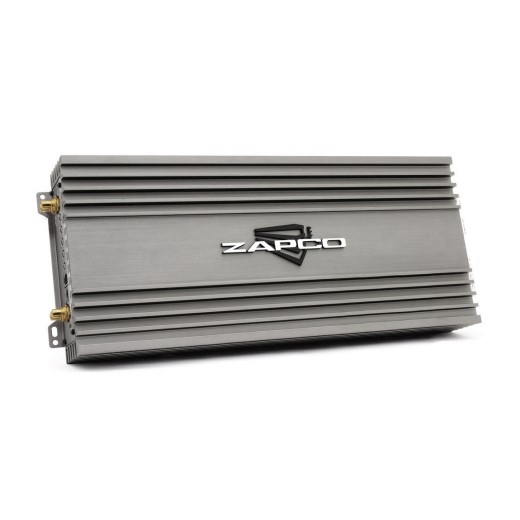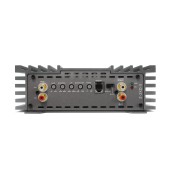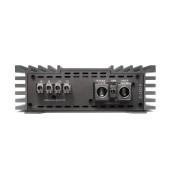Zapco Z-2KD II amplifier
More about the product
- Use our consulting room
- You can return the goods to us within 14 days
- Try the product at our store
Zapco Z-2KD II amplifier
In 2012, the first generation of the new Z model series was introduced, which is focused exclusively on sound quality. The amplifiers were created based on the references of audiophiles and car sound fanatics from all over the world. Therefore, the engineers at Zapco experimented with internal components and new circuits to see if it was possible to take Zapco amplifiers to an even higher level of sound quality by investing in audiophile components. The resulting Z series amplifiers were a product of this unique development method. Now, after several successful years, it was time to create the second generation of Z-series amplifiers. The main goal was to reduce the price by implementing the latest technologies and increasing production efficiency together with the higher model series AP and SP, which brought savings and the ability to keep consumer prices at a reasonable level. At the same time, several important components have been upgraded, so the amplifiers of the new Z II model series now provide even higher sound quality and at the same time lower end prices. A double win for fans of premium sound!
The main features of the Zapco Z-2KD II amplifier
- 1-channel class D amplifier
- Stable up to 1 Ω
- Possibility of connection with another amplifier
- PWM MOSFET power supply
- Tiffany-style RCA connectors
- Continuous input power control
- LP electronic crossover
- Socket input terminals
- Continuously adjustable bass boost
- Continuously adjustable phase shift and subsonic filter
- Remote control option
Important features of Zapco Z II amplifiers
Over the last few years, Zapco has developed two dedicated model lines that have taken sound to a whole new level. Z-AP amplifiers focused on sound quality, on which you will not find any setting options except for gain, because the amplifiers are intended exclusively for connecting a DSP processor. The Z-SP series, on the other hand, is for music fanatics who demand massive performance, continuous play and at the same time audiophile sound. However, now in 2021 comes the Z II series, which brings some interesting improvements:
- New TI operational amplifier for significantly better signal-to-noise ratio and general noise reduction.
- The same audiophile capacitors as used in the LX and SP amplifiers.
- Strengthening the power supply with less internal resistance and lower inductance for higher efficiency.
- Adding more MOSFETs to the power supply for more efficient current handling.
- Upgraded Tiffany-style RCA connectors.
- Plastic controls have been replaced with metal ones.
About Zapco Amplifiers
Zapco is the oldest high-end car audio brand in the world, specializing in high-end car amplifiers and DSP processors. The company was founded in the USA back in 1974 and has been collecting one award after another since then. And this both from prestigious organizations that evaluate the quality of products and innovations, as well as at global competitions focused mainly on sound quality. Zapco amplifiers represent audiophile quality without compromise, defining the standard of quality and setting the criteria by which other products in the industry are judged. At Zapco, for over 45 years, they have been constantly looking for innovative ways to bring better sound to the automotive environment, and this relentless pursuit of absolute sound quality has always resulted in new technologies and high-end products. Are you asking why? Because nothing else can capture the soul and bring tears to the eyes like music. Music can make you dance for joy..... of all the arts, music has the most powerful and immediate effect on your body and mind. Reproducing music in all its beauty and delicacy deserves nothing less than the best efforts of all Zapco employees. And also because music matters!
| Catalog number | Z-2KD II |
| Brand | Zapco |
| Links | Official web presentation (English) |
| Number of amplifier channelsAmplifiers are divided into: - Monoblocks - 2-channel - 3-channel - 4-channel - 5-channel - 6-channel - multi-channel Each channel is used to power one speaker for the coaxial type, or one side if they are component speakers. Monoblock type amplifiers are mainly used for subwoofers. 2-channel are suitable for both subwoofers and, for example, the front pair of speakers in a car. 3-channel is used for front or rear speakers + subwoofer. 4-channel are used for front + rear speakers or 1 pair of speakers + subwoofer. 6 or 5-channel are used for 2 pairs of speakers + subwoofer, most often. Bridging means connecting the amplifier to a bridge, using the + pole from one channel and the - pole from the other channel. In most cases this is shown as "BRIDGED" on the amplifier. | 1 |
| Energy class of the amplifierAmplifiers are divided into two basic classes: analog and digital . Analog amplifiers (A/B) have higher consumption requirements, but usually have a more natural sound. Digital amplifiers (D) have significantly lower consumption and higher efficiency, but the sound may not be as faithful as with classic analog amplifiers. | D |
| RMS power into 4 ΩRMS power when loading speakers or subwoofer at 4 Ω. RMS power is the constant power of the amplifier and is one of the most important parameters when choosing an amplifier. | 1 x 800W |
| RMS power into 2 ΩRMS power when loading speakers or subwoofer at 2 Ω. RMS power is the constant power of the amplifier and is one of the most important parameters when choosing an amplifier. | 1 x 1400W |
| RMS power into 1 ΩRMS power when the subwoofer is loaded at 1 Ω. RMS power is the constant power of the amplifier and is one of the most important parameters when choosing an amplifier. When connected to 1 Ω, significant heating of the amplifier may occur. | x 2100W |
| Low-pass filter (LPF)LPF / LP or "low pass filter" offers the possibility to adjust the amplifier using a potentiometer so that the lower band plays only the frequencies in a certain band that you need. This filter is used to adjust the frequency range for the subwoofer, so that it does not overload or distort the sound. Example: Amplifiers most often have an LPF from 20 to 300 Hz. We recommend setting this potentiometer in the range of 45-80 Hz. | 30 - 250 Hz |
| Harmonic Distortion (THD)Total harmonic distortion indicates how much the input signal is distorted in the amplifier. Distortions appear as overtones contained in the output signal. The proportion of originally absent parts of the signal is given as a percentage, typical values are between 0.001% and 0.5%. Distortion is measured in their power band. If it exceeds the limit of 0.7% from a certain power, it is the value of the output power of the given amplifier, from which it no longer plays without distortion and from which the distortion usually increases steeply, so that no further increase in power can be counted on. The lower the value, the better. | < 0.05% |
| Signal-to-noise ratioThe signal-to-noise ratio means that the output signal always contains noise. The signal-to-noise ratio expresses how much of this noise is compared to the useful signal. The so-called A value is given, which does not take deep and very high frequencies into account. This corresponds to the characteristic of human hearing, which is not so sensitive to deep frequencies, especially below 1 kHz. The higher the value, the better the amplifier is. | > 90 dB |
| Input sensitivityIn order for the amplifier to perform its function correctly, it requires an input signal of a certain level, which is different for car radios. It is measured in "Volts" (e.g. 2 V, 4 V, etc.) The higher the value at the output of the pre-amplifier, or car radio, the less demands are placed on the power of the amplifier. However, the amplifier must allow this input sensitivity, and for that reason this value is also given for the amplifier. | 0.5 - 8 V |
| Bass boostBass boost or bass enhancement. With this function, the bass itself can be emphasized, at a high level of bass boost, the speakers and the subwoofer can distort a lot and the sound will be worse than better. We therefore recommend using the "bass boost" function wisely. With maximum use of bass boost, there is a risk of damage to the speakers and thus to the subwoofer. | 0 - 12 dB |
| Phase shiftPhase shift is a linear electronic oscillator that produces a sinusoidal output. It consists of an inverting part of the amplifier such as a transistor. The feedback network "shifts" the phase at the output of the amplifier by 180 degrees to the oscillation frequency and gives positive feedback. The Phase shift filter produces a phase shift that increases with increasing frequency. This is usually used when the subwoofer sub-assembly is out with the magnet, or when two amplifiers are connected externally. Phase Shift is also used with active speaker wiring, where the time shift of the speakers is set. The point is that the subwoofer does not play the bass late, and for this reason better amplifiers offer this phase reversal option. | Yes |
| SubsonicA subsonic filter is essentially a high-pass filter for very low frequencies, typically 45 Hz or lower. Anything below this setting is weakened. The point is that the subwoofer does not go below the subsonic filter setting and does not overload itself with very low frequencies. A useful function, if set correctly, the subwoofer is not overloaded. | 10 - 60 Hz |
| Damping factorDF - Damping Factor . It is the ratio of the load (repro + cables, crossover, etc.) to the internal resistance of the amplifier. The bigger the DF, the more controlled the bass. Amplifiers with a lower DF tend to hum. Subwoofers with a higher Q in the bass reflex and sometimes in the enclosure will also cause humming. | > 350 |
| High level inputsThe high-level input on the amplifier allows connection directly to the existing speakers in the car without additional purchase of an external high/low adapter. Important equipment in the case of installing an amplifier on an original car radio. | No |
| Socket input terminalsFerrule terminals allow better wiring contact to the amplifier. It is also a more secure form of terminals. If you are tightening the sleeve terminals, we recommend retightening them after 1 day, as the connected cable gradually compresses. | Yes |
| Remote control included in the packageSome models of amplifiers also come with wired remote controls in the package, which on one side plug into the amplifier and on the other side you have a potentiometer that you can place anywhere in the cabin. A common place to place the remote control is under the steering wheel. The advantage is the regulation of power, and therefore volume, depending on driving conditions and the mood of the crew in the car. | No (possible to purchase) |
| Dimensions of the amplifier | 190 x 62 x 450 mm |





















